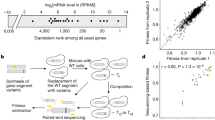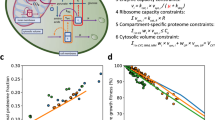Abstract
Under laboratory conditions 80% of yeast genes seem not to be essential for viability1. This raises the question of what the mechanistic basis for dispensability is, and whether it is the result of selection for buffering or an incidental side product. Here we analyse these issues using an in silico flux model2,3,4,5 of the yeast metabolic network. The model correctly predicts the knockout fitness effects in 88% of the genes studied4 and in vivo fluxes. Dispensable genes might be important, but under conditions not yet examined in the laboratory. Our model indicates that this is the dominant explanation for apparent dispensability, accounting for 37–68% of dispensable genes, whereas 15–28% of them are compensated by a duplicate, and only 4–17% are buffered by metabolic network flux reorganization. For over one-half of those not important under nutrient-rich conditions, we can predict conditions when they will be important. As expected, such condition-specific genes have a more restricted phylogenetic distribution. Gene duplicates catalysing the same reaction are not more common for indispensable reactions, suggesting that the reason for their retention is not to provide compensation. Instead their presence is better explained by selection for high enzymatic flux.
This is a preview of subscription content, access via your institution
Access options
Subscribe to this journal
Receive 51 print issues and online access
$199.00 per year
only $3.90 per issue
Buy this article
- Purchase on SpringerLink
- Instant access to full article PDF
Prices may be subject to local taxes which are calculated during checkout



Similar content being viewed by others
References
Giaever, G. et al. Functional profiling of the Saccharomyces cerevisiae genome. Nature 418, 387–391 (2002)
Forster, J., Famili, I., Fu, P., Palsson, B. O. & Nielsen, J. Genome-scale reconstruction of the Saccharomyces cerevisiae metabolic network. Genome Res. 13, 244–253 (2003)
Famili, I., Forster, J., Nielsen, J. & Palsson, B. O. Saccharomyces cerevisiae phenotypes can be predicted by using constraint-based analysis of a genome-scale reconstructed metabolic network. Proc. Natl Acad. Sci. USA 100, 13134–13139 (2003)
Forster, J., Famili, I., Palsson, B. O. & Nielsen, J. Large-scale evaluation of in silico gene deletions in Saccharomyces cerevisiae. OMICS 7, 193–202 (2003)
Segre, D., Vitkup, D. & Church, G. M. Analysis of optimality in natural and perturbed metabolic networks. Proc. Natl Acad. Sci. USA 99, 15112–15117 (2002)
Steinmetz, L. M. et al. Systematic screen for human disease genes in yeast. Nature Genet. 31, 400–404 (2002)
Wagner, A. Robustness against mutations in genetic networks of yeast. Nature Genet. 24, 355–361 (2000)
Gu, Z. et al. Role of duplicate genes in genetic robustness against null mutations. Nature 421, 63–66 (2003)
Gu, X. Evolution of duplicate genes versus genetic robustness against null mutations. Trends Genet. 19, 354–356 (2003)
Stelling, J., Klamt, S., Bettenbrock, K., Schuster, S. & Gilles, E. D. Metabolic network structure determines key aspects of functionality and regulation. Nature 420, 190–193 (2002)
Papin, J. A., Price, N. D., Wiback, S. J., Fell, D. A. & Palsson, B. O. Metabolic pathways in the post-genome era. Trends Biochem. Sci. 28, 250–258 (2003)
Emmerling, M. et al. Metabolic flux responses to pyruvate kinase knockout in Escherichia coli. J. Bacteriol. 184, 152–164 (2002)
Kitami, T. & Nadeau, J. H. Biochemical networking contributes more to genetic buffering in human and mouse metabolic pathways than does gene duplication. Nature Genet. 32, 191–194 (2002)
Pál, C., Papp, B. & Hurst, L. D. Rate of evolution and gene dispensability. Nature 421, 496–497 (2003)
Thatcher, J. W., Shaw, J. M. & Dickinson, W. J. Marginal fitness contributions of nonessential genes in yeast. Proc. Natl Acad. Sci. USA 95, 253–257 (1998)
Edwards, J. S. & Palsson, B. O. The Escherichia coli MG1655 in silico metabolic genotype: its definition, characteristics, and capabilities. Proc. Natl Acad. Sci. USA 97, 5528–5533 (2000)
Daran-Lapujade, P. et al. Role of transcriptional regulation in controlling fluxes in central carbon metabolism of Saccharomyces cerevisiae: a chemostat culture study. J. Biol. Chem. 279, 9125–9138 (2004)
Nakao, M. et al. Genome-scale gene expression analysis and pathway reconstruction in KEGG. Genome Inform. Ser. Workshop Genome Inform. 10, 94–103 (1999)
Schilling, C. H., Edwards, J. S., Letscher, D. & Palsson, B. O. Combining pathway analysis with flux balance analysis for the comprehensive study of metabolic systems. Biotechnol. Bioeng. 71, 286–306 (2000)
Wagner, G. P., Booth, G. & Bagheri-Chaichian, H. A population genetic theory of canalization. Evolution 51, 329–347 (2000)
Seoighe, C. & Wolfe, K. H. Yeast genome evolution in the post-genome era. Curr. Opin. Microbiol. 2, 548–554 (1999)
Papp, B., Pal, C. & Hurst, L. D. Dosage sensitivity and the evolution of gene families in yeast. Nature 424, 194–197 (2003)
Gerdes, S. Y. et al. Experimental determination and system level analysis of essential genes in Escherichia coli MG1655. J. Bacteriol. 185, 5673–5684 (2003)
Kobayashi, K. et al. Essential Bacillus subtilis genes. Proc. Natl Acad. Sci. USA 100, 4678–4683 (2003)
Kamath, R. S. et al. Systematic functional analysis of the Caenorhabditis elegans genome using RNAi. Nature 421, 231–237 (2003)
Hutchison, C. A. et al. Global transposon mutagenesis and a minimal Mycoplasma genome. Science 286, 2165–2169 (1999)
Glasner, J. D. et al. ASAP, a systematic annotation package for community analysis of genomes. Nucleic Acids Res. 31, 147–151 (2003)
Altschul, S. F. et al. Gapped BLAST and PSI-BLAST: a new generation of protein database search programs. Nucleic Acids Res. 25, 3389–3402 (1997)
Mewes, H. W. et al. MIPS: a database for genomes and protein sequences. Nucleic Acids Res. 30, 31–34 (2002)
Acknowledgements
We thank J. Förster and B. Palsson for discussions and providing information on the yeast flux balance model. We also thank J. Glasner for providing growth data on the E. coli wild-type strain. B.P. and C.P. were supported by the Hungarian National Research Grant Foundation (OTKA).
Author information
Authors and Affiliations
Corresponding author
Ethics declarations
Competing interests
The authors declare that they have no competing financial interests.
Supplementary information
Supplementary Information
Contains: Table S1a. Comparison of experimentally estimated flux values with predicted ones under four growth conditions; Table S1b. The model predicts presence or absence of fluxes with 91-95% success in central carbon metabolism; Table S2a. In silico flux values of selected metabolic reactions; Table S2b. Average in silico flux values of major metabolic units; Table S3. Comparison of predicted and measured gene dispensability on rich medium with glucose (YPD); Table S4. Causes of metabolic gene dispensability; Table S5. What explains failure of compensation by a duplicate? Figure S1. The extent of flux reorganisation correlates with predicted fitness effect of the knock-out; Table S6. No association between importance of reactions and presence of isoenzymes; Table S7. Reactions catalysed by isoenzymes have larger fluxes than those catalysed by solo copy enzymes; Figure S2. Distribution of environmental specificity of fitness defects of Escherichia coli mutant strains; Figure S3. Phylogenetic distribution of E. coli genes correlates with environmental specificity of mutant phenotypes; Table S8. Calculation of phylogenetic distribution of E. coli genes; Equation S1. Biomass equation used for metabolic simulations; Figure S4. Distribution of predicted growth rates for knock-out strains; References. (DOC 165 kb)
Rights and permissions
About this article
Cite this article
Papp, B., Pál, C. & Hurst, L. Metabolic network analysis of the causes and evolution of enzyme dispensability in yeast. Nature 429, 661–664 (2004). https://doi.org/10.1038/nature02636
Received:
Accepted:
Issue Date:
DOI: https://doi.org/10.1038/nature02636




